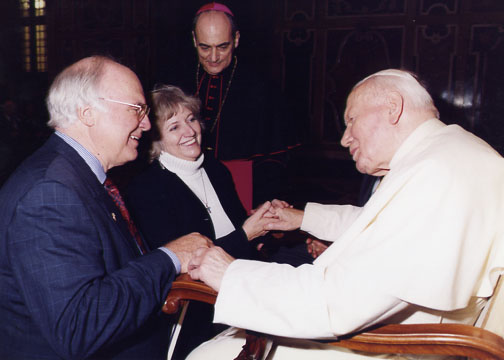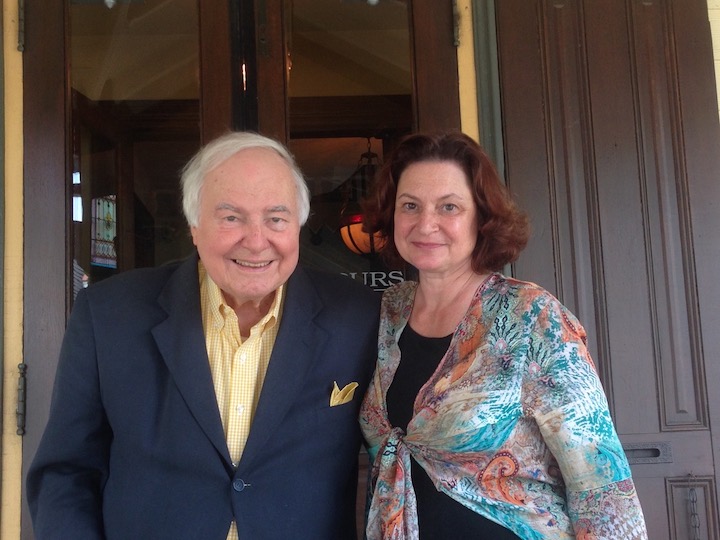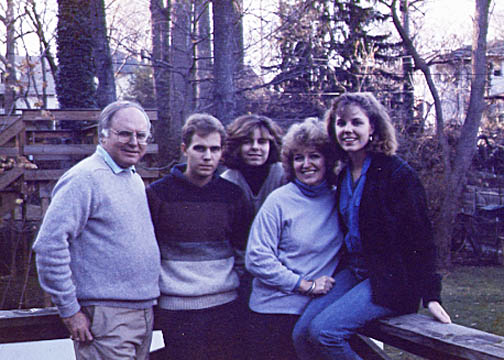Michael Novak was a thinker whose sweep was without peer in his time, or ours. As a public intellectual, his contributions ranged over a staggering list of fields – theology, philosophy, journalism, economics, politics, poetry and fiction – just for starters. His public service included work as an ambassador for human rights, as a professor, as a public speaker in great demand; and his service was recognized by a staggering list of honors: 24 honorary degrees, the Templeton Prize for Progress in Religion, awards from the Central European governments and associations for whom his towering work, The Spirit of Democratic Capitalism, would serve as a providential blueprint during the years in which they clawed up from decades of communist oppression.
Peering into Michael’s legacy can’t help but make anyone feel inadequate to the task of addressing any of it. I’d like to focus on one aspect of Michael that deserves more attention in the public eye: that is Michael Novak, Catholic, and the influence of Catholicism throughout his life’s work.
Of course, he was always identified as a “Catholic intellectual.” But in a secularizing age, it bears special emphasis that Michael’s Catholicism was the irreducible nucleus that held together every orbit in which his life’s work was spinning, and spins still.
Today I would like to give five examples as evidence for that proposition. Michael, of course, was an intuitive Trinitarian. He had a great fondness for arguments made in sets of three. But I like to think he would approve my giving five examples instead of three. Five is more than three, after all! And amplifying the discussion of his work was not something he was known to discourage. So let us consider how Michael Novak, Catholic, accounts for Michael Novak, public intellectual.
#
The first and most obvious way is his lifelong preoccupation with a question central to the Gospels: helping the poor.
This concern lies at the heart of The Spirit of Democratic Capitalism. Because its author could remain focused on what would benefit the least among us, he could see what others could not – namely, where improvement really came from. The “inventors and discoverers in many fields of business” were not the secular demons of progressives since at least Karl Marx, but rather human beings who were “benefactors of the human race.”
“Better eye care, dental services, hygienic products, vaccinations, and ‘miracle cures’ were saving lives in almost every family known to me,” as he puts the point in plain English. “Older people who a generation earlier would have been dead were still living, and in many ways living better.”
For such pragmatism, of course, Michael has been excoriated by critics who spied in this re-humanizing of capitalists something sinister – a “sacralization” of democratic capitalism, as one particularly emotional dissenter put it. But such arrows have always missed the moral mark. I would like to make three points in passing about Michael’s defense of economic liberty.
First is a moral point. Critics on the left, yesterday as today, suffer a blind spot. They fail to understand that arguments on behalf of capitalism might be driven by something other than sinister motives. Theirs is a lapse of charity. This is the deeper meaning, for example, of the call today that “every billionaire represents a policy failure.” No, he or she does not. He or she is a human being made in the image of God, like everyone else. Today’s progressivism, like yesterday’s socialism, runs a real risk of dehumanizing opponents and reducing them to their bank accounts. Michael Novak never shared in that error, and for no nefarious reason. He could see with the eyes of the poor themselves what capitalism had given the world. He also knew, unlike some opponents, that an epithet is not an argument.
Second, Michael’s robust defense of economic freedom was never about Ayn Randian straw supermen. He believed, and argued over and over, that economic liberty was the setting most conducive to human thriving for human beings living in community– specifically, the community of the family.
As one rarely if ever heard from his critics, then or now, chapter VIII of The Spirit of Democratic Capitalism is all about the repudiation of the notion that capitalism is for isolated individuals. There, he criticized the libertarian assumption, present in most textbooks on economics, that the individual stands at the center of economic activity, and that capitalism is designed to serve that individual.

He also made this point: “Insofar as democratic capitalism depends for its economic vitality upon deferred gratification, savings, and long-term investment, no motive for such behavior is the equivalent of regard for the future welfare of one’s own progeny.” The texture of life under democratic capitalism, he repeated, is centered more on the family than the individual. In all of this, he was correct.
The great crackup of our time, the anxiety that pervades our politics and society today, can be read as an indictment of many things – failed policies, human frailty, above all, the sexual revolution. But capitalism per se is not one of them.
Third, and like other neo-conservatives who have become much maligned for similar defenses, Michael’s understanding of capitalism appealed as its final witnesses to the poor. As he put it in his address upon winning the Templeton Prize, “for all its deficiencies, even gaping inadequacies, capitalism is better for the poor than either of its two great rivals, socialism and the traditional Third World economy. Just watch in which direction the poor of the world invariably migrate. The poor – of whom my family in living memory was one – know better than the intellectuals.” This is no sacralization of economics, but American pragmatism making a moral point.
#
A second way in which Catholicism reveals itself as the center of his thought can be seen in Michael’s preoccupation with caritas.
There was no dearer subject to Michael Novak than love – and his understanding of love was not the schmaltz of Jonathan Livingston Seagull. It was undiluted Thomism. In a festschrift compiled for Michael’s 80th birthday, An American and Catholic Life, professor Elizabeth Shaw, his longtime colleague and collaborator, wrote a beautiful essay about what she called the “golden thread” of Michael’s work. That is the notion of caritas, which she defines as the “self-generating, self-sustaining, and self-diffusing love of the Trinity.” As such a description makes clear, this is an intensely Catholic understanding. It would be impossible to understand Michael’s work without grasping something of the essence of caritas, as Elizabeth’s essay indicates. I would like to touch briefly on two examples.
On the theoretical plane, Michael had much to say about Caritapolis, or the Civilization of Love. This is the civilization optimal for human flourishing. What does it look like? It is centered on a Thomistic understanding of love, that is, love that wills the good of another. Throughout his writings on Caritapolis, Michael takes pains to distinguish that city from one that is ideal and unattainable. “To think in a utopian way is a sin against Caritapolis,” as he put it in one of his last books, Social Justice Isn’t What You Think It Is. His was not a Platonic understanding of what an ideal city might look like. It was rather a deeply Catholic understanding of the intrinsically relational and sacrificial nature of love.
This same Thomistic understanding of love is one that Michael lived out in real life. A few years ago, when he was thinking of publishing some of the love letters that he and Karen had written to one another before marriage, he asked me to read through them with an eye toward writing an introduction. I mention this here because in those letters, on the part of both writers, an extraordinarily mature desire for the well-being of the other is apparent from early on.
In one of his earliest letters, Michael urges Karen to try for a Guggenheim or other prize, like the Prix de Rome. A letter or two later, he advises her to mount an informal showing of her artistic work and adds that he is looking forward to the first formal one. He learns about art for her sake; he coaches and otherwise fills her in about his writing. Later on, when she does win a painting prize, perhaps frustrated by her diffidence (at least compared to his lack of it), he urges that “You’ve got to learn how much pleasure your work will bring to people and how deep your talent runs.”
Karen, for her part, repays the interest: consoling him over disappointment in his novel’s sales and otherwise encouraging him to keep her involved in his writing. Just a few months into their correspondence she writes sweetly that, “It would be such fun if you would write a few short things (poetry or stories) sometime and I could illustrate, set the type and print it.” It is an impulse to collaboration that foreshadows what will become their greatest joint work of all: the 46 years spent together following their marriage.

Throughout life, Michael showed the same Thomistic grace not only in willing the best for his friends. He also worked overtime to make it happen. Here’s one example among many. In 2010, Michael gave the floor to a discussion of my first work of fiction, The Loser Letters, an unlikely tale about a young woman in rehab, wrestling with questions of atheism and theism. Upon hearing our daughter Catherine, an actress, read some lines from the book aloud, Michael announced: “This story should be a stage-play.” He kept insisting on it. Six years later, his prediction became reality: The play premiered at Catholic University’s Hartke Theatre in fall 2016 for a two-week run.
#
A third way in which Michael’s legacy remains unthinkable apart from his Catholicism concerns a philosophical point. That is his lifelong grappling with a profound question: what is knowable, and what is not.
A good thinker will understand that there are things we cannot know. But only a great thinker can discern where the lines are, because only a great thinker pushes logic all the way to the boundaries. And so, paradoxically, only those who know most are capable of understanding just what they cannot know. Michael was that thinker.
Consider his 2008 book, No One Sees God: The Dark Night of Atheists and Believers, that was published at the height of the New Atheism, and as a response to that same phenomenon.
In it, Michael made a characteristically bold move. Instead of excoriating atheism, he invited its proponents to join him in meditating on the fact that doubt is intrinsic to the human condition, that we are all a community of doubters, and that there is a purpose to this doubt. Children love in order to be loved in return. Mature love is something else. Doubt teaches us to “love for the sake of love,” Michael writes. Atheists and religious believers are not as estranged as they assume. The point is less to believe in God than to know Him, and the only way to know Him is by a brave, blind leap into what is not only unknown, but unknowable.
Also characteristic, the author makes this rich argument with a dazzling display of religious erudition worn lightly, from the story of Elijah in the cave on through the writings of a prodigious list of thinkers, old and new, especially the great Christian mystics, to whom he returned, as Karen perpetually returned to them in her art.
The point is that No One Sees God was an inescapably Catholic response to the New Atheism. It was evangelical in its approach to opponents, Chestertonian in its grasp and depiction of paradox, and suffused with a universality grounded in a Catholic understanding of what is common to all humans as humans, whether inside the Church or out.
In the present moment, one hears much empty talk of civility, and much handwringing about divisiveness in America. There is no better way to overcome division than to engage one’s opponents with respect and use reason to establish common ground. Michael repeatedly used reason as an end run around acrimony. This, too, is a lesson drawn explicitly from Catholic tradition, according to which logic, correctly applied, reveals truth.

#
Fourth, Catholicism was essential to Michael in one of his other incarnations: as a saloniste par excellence, a longstanding social impresario and mentor on a bounteous scale.
One of his favorite quotations was James Joyce’s description of Catholicism: “Here comes everybody.” I don’t know how accurate a summary that may be about the Catholic Church in this present, anxious moment. But I do know that “here comes everybody” was a superb way of describing the Novak dinner table.
Michael and Karen’s salon in Washington, D.C. was a powerhouse of colleagues from the American Enterprise Institute and related communities, plus any number of other names, household and otherwise, along with interns and other people’s children.
Then there were the seaside dinners at their home in Delaware, which doubled as Karen’s art studio and a summer retreat for visiting students from Ave Maria University. On any given night, the cast of characters in the Novak summer home might include, in addition to Michael, rotating family members like sister Mary Ann and brother Ben and daughter Jana; rotating students who added an antic energy to the cooking and cleaning and after-dinner ruminations, as well as providing free entertainment in the form of poetry and live music; rotating Eberstadts, and their friends, and their children, and sometimes their children’s friends.
The conversations were cerebral, like the ongoing discussions of Catholic capital-S social doctrine. Less noticed but perhaps even more important was that the reigning law of these soirees was Novakian Catholic small-s social doctrine; according to which everyone would be included, no matter how big or small.
One of the last things he ever wrote, for example – to our knowledge, the last thing – was a letter of recommendation to Columbia University’s graduate program in acting for a former Ave Maria student named Peter Atkinson. Peter has gone on to serious theatrical work even as a student. How it would have thrilled Michael to see that this winter, Peter starred in a production of Eugene O’Neill’s “Ah, Wilderness.” This was the kind of mentorship Michael lived for: helping faithful Catholics into artistic and professional life, including circles dominated by secular, postmodern ideology. This was the kind of outcome that he had in mind in devising his last creation, the American Academy for Catholic Thinkers and Artists, about which more in a moment.
#
Fifth and finally, another measure of Michael’s ineradicable universalism can be found in the figurative homes over the years that he built or helped to build for other thinkers. He could not stop creating communities for ideas, with outstanding and ongoing results.
First Things magazine really is the most influential journal of religion and ideas in the English-speaking world. The Tertio Millennio Seminar in Krakow, Poland, now led by George Weigel, has resulted in a community of ardent, educated Catholic leaders from Central Europe and the United States. So has the Slovak Summer Seminar on the Free Society led by Robert Royal.
What most people do not know about, however, is Michael’s last effort at institution building, which absorbed much of his time and attention during the last two years, and with which a widening circle of friends tried to help. This was his blueprint for an explicitly Catholic society of elite thinkers, modeled on the Academie Francaise. In the course of several meetings in Delaware over two summers, some of us discussed at length the need for an association of artists and writers to serve as a counterforce against the secularist progressivism so dominant in the arts and in the academy today.
We also tried to hammer out ways to build that thing. The summer before Michael died, those years of talk and that vision finally produced fruit: The American Academy for Catholic Thinkers and Artists met in miniature, fittingly enough, for three days of seminar by the beach in summer, 2016. Those present included, in addition to Michael: Robert Royal, Hadley Arkes, Igor Babailov, Patrick Cassidy, Fr. Thomas Joseph White, and myself, as well as Aurora and Paul Griffin. We also spoke of using the group for different forms of mentorship, bringing junior members into the ranks to benefit from more senior ones and to ensure continuity. One of Michael’s deathbed requests to Bob Royal and to me was that we see to it that AACTA would live on.
That fledgling creation illuminates all over again the theme before us: Michael’s last serious effort, like those throughout his life, was Catholic to the core. One quotation making the rounds often today is that of Pope Paul VI, who observed that “Modern man listens more willingly to witnesses than to teachers, and if he does listen to teachers, it is because they are witnesses.” Michael Novak was indeed a teacher — to students and statesmen, colleagues and critics, and past, present, and future generations of readers around the world. But he was also, in ways easy to overlook, a Catholic witness to the faith, one whose fearlessness about speaking of things Catholic made him an example. It was his spiritual adventure, his love for the Church and his faith, that made possible his dazzling intellectual, social, and political legacies.















